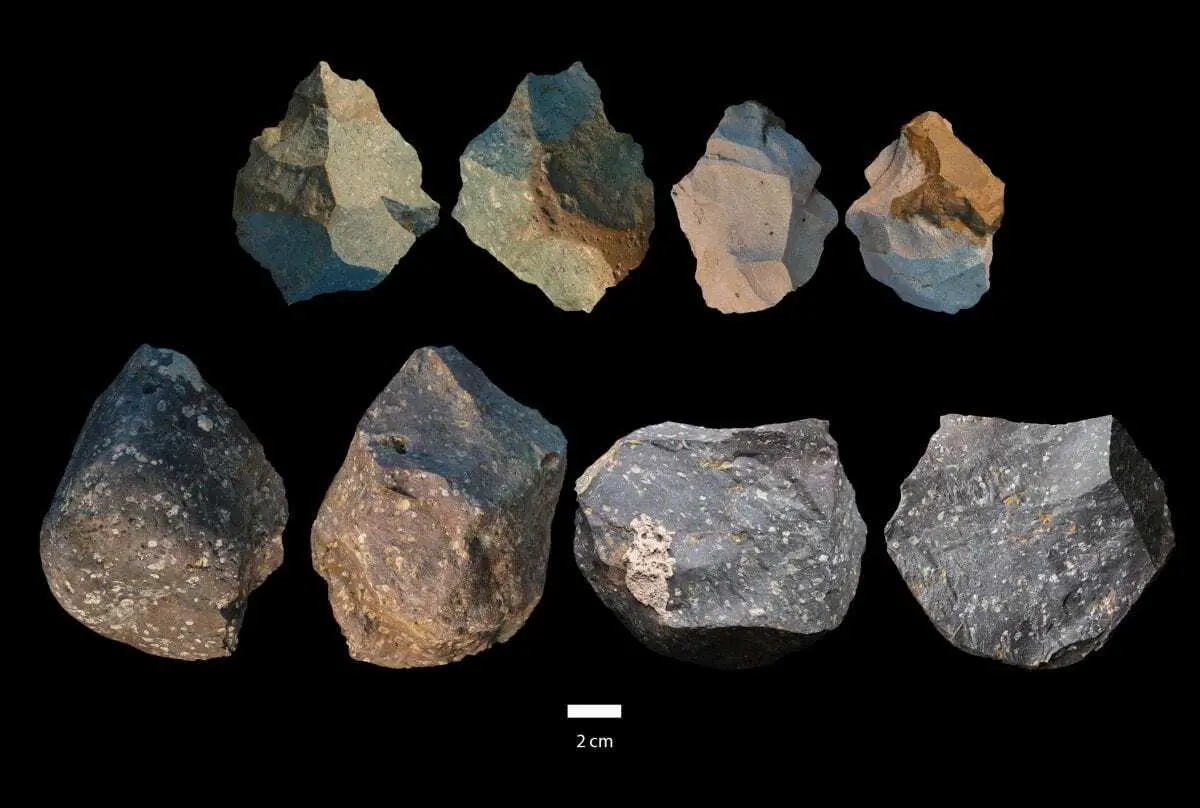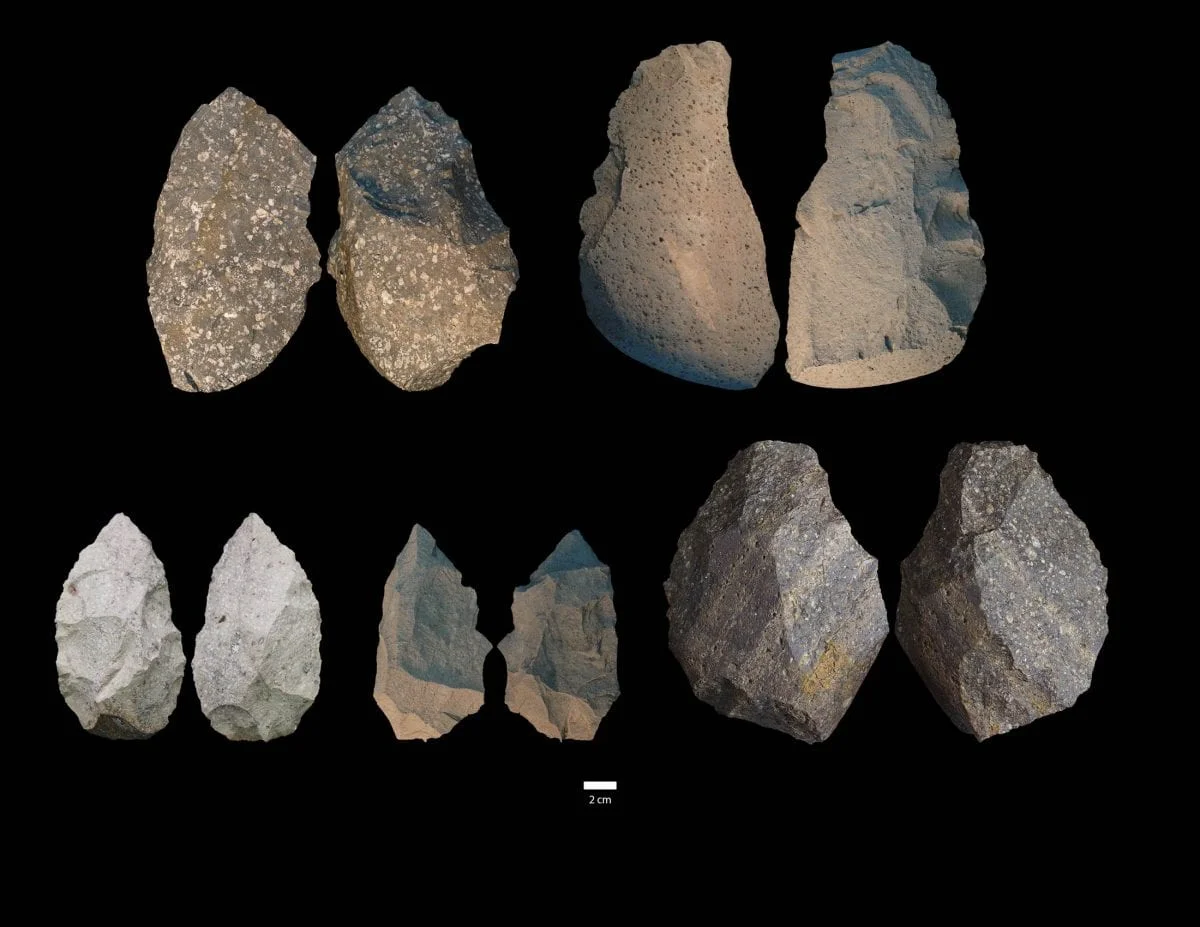The smallest Homo erectus cranium in Africa and diverse stone tools found at Gona, Ethiopia, indicate that human ancestors were more varied, both physically and behaviorally than previously known.
Sileshi Semaw, from CENIEH (Burgos, Spain), and Michael Rogers, from SCSU (Connecticut, USA), together with their research team have discovered a nearly-complete hominin cranium estimated to 1.5 million years, and a partial cranium dated to 1.26 million years from the Gona study area, in the Afar State of Ethiopia. Both crania, assigned to Homo erectus, were associated with both simple Oldowan-type (Mode 1) and more complex, Acheulian (Mode 2) stone tool assemblages.
The nearly-complete cranium was discovered at Dana Aoule North (DAN5) and the partial cranium at Busidima North (BSN12), sites that are 5.7 km apart. Remarkably, the DAN5 cranium has the smallest endocranial volume documented for Homo erectus in Africa, about 590 cubic centimeters, probably representing a female. This cranium bears some similarity to the small individuals discovered at Dmanisi (Republic of Georgia), and dated to 1.8 million years. The BSN12 partial cranium is robust and large (similar to OH 9 from Olduvai Gorge), while the DAN5 cranium is smaller and more gracile, suggesting that Homo erectus was probably a sexually dimorphic species.
This physical diversity is mirrored by the stone tool technologies exhibited by the artifacts found in association with both crania. Instead of only finding the expected large handaxes or picks (signature tools of Homo erectus), the Gona team found both well-made handaxes and plenty of less-complex Oldowan tools and cores. This suggests that Homo erectus had a degree of cultural/behavioral plasticity that has yet to be fully understood.
Scott. Simpson, a co-author of the study, commented that “In the almost 130 years since its initial discovery in Java, Homo erectus has been recovered from many sites across Eurasia and Africa. The new remains from the Gona study area exhibit a degree of biological diversity in Africa that had not been seen previously, notably the small size of the DAN5 cranium. The BSN12 partial cranium also provides evidence linking the African and eastern Asian fossils demonstrating how successful Homo erectus was.”


Environmental setting and carnivory
The DAN5 and BSN12 sites at Gona are among the earliest examples of Homo erectus associated with both Oldowan and Acheulian stone assemblages. The toolmakers at both sites lived in close proximity to ancient rivers, in settings with riverine woodlands adjacent to open habitats. The low δ13C isotope value from the DAN5 cranium (from the right M1) is consistent with a diet dominated by C3 plants (trees, shrubs) or, alternatively, broad-spectrum omnivory.
Homo erectus at Gona used locally-available stone cobbles to make their tools, which were accessed from the nearby riverbeds. Fossil fauna was abundant at BSN12, but cutmarks or hammerstone-percussed bones were not identified. At DAN5, an elephant phalanx was found with stone tool cutmarks, and a small antelope leg bone had a percussion notch, implying that H. Erectus butchered both large and small mammals, though it is not clear whether they hunted or scavenged their prey.
Significance
There is a common view that early Homo (e.g. Homo habilis) invented the first simple (Oldowan) stone tools, but when Homo erectus appeared 1.8-1.7 million years ago, a new stone tool technology called the Acheulian, with purposefully-shaped large cutting tools such as handaxes, emerged in Africa. The timing, causes and nature of this significant transition to the Acheulian by 1.7 million years is not entirely clear, though, and is an issue debated by archaeologists.
Our investigations at DAN5 and BSN12 have clearly shown that Oldowan technology persisted much longer after the invention of the Acheulian, indicative of a particular behavioral flexibility and cultural complexity practiced by Homo erectus, a trait not fully understood or appreciated in paleoanthropology.
Semaw says, “Although most researchers in the field consider the Acheulian to have replaced the earlier Oldowan (Mode 1) by 1.7 million years, our research has shown that Mode 1 technology actually remained ubiquitous throughout the entire Paleolithic.” Rogers adds, “The simple view that a single hominin species is responsible for a single stone tool technology is not supported. The human evolutionary story is more complicated.”
It is important to note that the first hominins that migrated out of Africa probably left with Oldowan technology, traveling as far as Dmanisi in Georgia by 1.8 Ma. The Acheulian, then, was likely invented by a Homo erectus population that evolved in Africa. Semaw suggests that, “it’s still possible that the descendants of the hominins who migrated earlier to the Caucasus could have migrated back to Africa, as others also have argued that H. erectus evolved in Asia and possibly returned back to Africa.”
Interestingly, other than DAN5 and BSN12, the crania from Buia (in Eritrea) and Daka (from the Middle Awash study area) are the only two H. erectus cranial specimens known in the entire Afar in the 1.5-1.0 Ma critical time interval. Konso is the only other Ethiopian site that has produced H. erectus (from southern Ethiopia), and the Gona team has previously reported the first female Homo erectus pelvis known, dated to 1 million years. Thus, DAN5 is quite a rare discovery, and more hominins associated with stone artifacts are needed (2.0-0.5 million years) in order to better understand issues regarding Homo erectus stone technology, physiology, mobility across continents, etc.
Some argue that in Africa multiple hominin species may have been responsible for the two distinct contemporary stone technologies (Oldowan and Acheulian). To the contrary, the evidence from Gona suggests a lengthy and concurrent use of both Oldowan and Acheulian technologies by a single long-lived species, Homo erectus, the variable expression of which deserves continued research. Rogers suggests that “one challenge in the future will be to understand better the stone tool attributes that are likely to be passed on through cultural tradition versus others that are more likely to be reinvented by different hominin groups.”
Gona sites
Gona is located in the Afar Triangle of Ethiopia, adjacent to the well-known Middle Awash and Hadar study areas, were the famous skeletons “Ardi” and “Lucy” were found, respectively. The research team has been investigating the Gona deposits since 1999, and the BSN12 partial cranium was discovered by Dr. N. Toth (Stone Age Institute, Indiana University) during the first season. The DAN5 cranium was found a year later in 2000 by the late Ibrahim Habib (local Afar colleague) on a camel trail.
Header Image – DAN5 cranium – Credit : Michael J. Rogers





